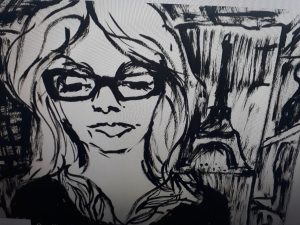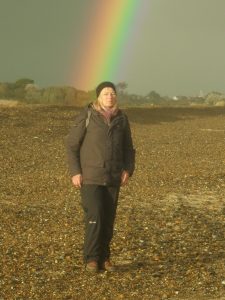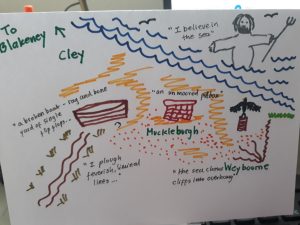The Saltwater Diaries (Hedgehog Poetry Press) was finally launched on 21 September 2020 to a wonderful audience of poetry friends and family and since then I’ve been lucky enough to read from the pamphlet at Aldeburgh Poetry Festival. This year the Festival was on-line and I so missed being able to stroll on the shingly beach between readings, banging into poet friends both old and new all over the town. But, but, every cloud really does have a silver lining – it appears I have a stress fracture on my left legbone and it has been very difficult for me to walk any distance so Aldeburgh in real life would not have happened for me, ironically. I read with wonderful poets Maria Isakova Bennett, Katrina Naomi and Martin Malone, each of us reperesenting a different part of the UK. Henny Beaumont was the artist-in-residence and I was delighted to have a portrait sketched by this talented artist as I read.

Sue in Aldeburgh – Henny Beaumont
Those of you who know me well will understand how frustrating it is for me not to be able to walk, albeit temporarily. Both pamphlets, Lumiere and The Saltwater Diaries were written as a result of a multitude of different walks. In Lumiere I becamea flaneuse, following in Baudelaire’s urban footsteps, and in The Saltwater Diaries I devoured the Norfolk coast path in bite-size chunks. I thought I would dedicate this blog to the places which inspired The Saltwater Diaries. These are places I can’t visit until I’ve healed, but through the power of my imagination and some very amateurish map drawings, I can be there in spirit!
At the beginning of October we did manage to get away to real-life Southwold for a couple of days and this is really the place where The Saltwater Diaries began. When I was at the University of East Anglia teaching English to the international students we would organise cultural field trips and it was while researching a trip to Blythburgh and Southwold that I discovered the legend of Black Shuck, the devil dog who comes out at night and spells death within a year to those who encounter him. You can find devil dogs all around the coast and, allegedly, while staying in Cromer Hall, Arthur Conan Doyle heard the legend of Shuck and went on to write The Hound of the Baskervilles. I firmly believe that Shuck is a creation of the local smugglers who wanted to keep the local population indoors while they went about their business.

I’ve written about this area of Suffolk many times before and have a poem Legends of Suffolk in my first collection. Once, as legend has it, Black Shuck tore through the congregation at Blythburgh Church on a murderous spree and left scorching clawmarks on the church door as he left which are still visible today.
Equally worthy of poems and stories are the towns up the coast from the Blythe Estuary. This mysterious, marshy and woodland area boasts both the village of Walberswick, accessible by ferry from Southwold, and the town of Dunwich – or rather, the remains of Dunwich as much of the important medieval port was swept to sea in a momentous thirteenth century storm and subsequent erosion has reduced it to the size of a village. They say you can hear the bells of the sunken churches when the wind and tide are right…. Go to this website and scroll down to see a revelatory map of this area’s ongoing coastal erosion:
We walked from Southwold to Dunwich and back again with a wary eye on the weather which, at one point, was totally different in each compass direction with the sky behind us looking positively apocalyptic. A brief drenching followed by sunshine led to one of the brightest rainbows I’ve ever seen. Here’s proof that there’s a poet at the end of every rainbow:

As we walked back to Southwold with the marshes on one side and the harbour on the other, the marshes emitted an eerie, otherwordly smell of sulphur as the sun set bloodily across the big skies. A fitting end to a wild day.
The Norfolk coast has been my main inspiration for the poems in The Saltwater Diaries with Revenant written on the cliffs at Weybourne after a journey back from Paris the night before. This was a day of double rainbows and I felt so disoriented – plucked from the grey, filtered January light of Paris to the windswept birdcalls of North Norfolk. There were even a couple of puffins out at sea, no doubt as disoriented as me!

In a further extraordinary feat of disorientation, Weybourne Beach (shingle, cliffs) recently stood in for Great Yarmouth (sandy, no cliffs) in Armando Iannuci’s superb recent adaptation of David Copperfield, starring Dev Patel as a thoroughly engaging David.

Marginalia, which begins with the lines:
Today I am full of winter/unnatural with mucus and itch
was written on a day when I thought I was recovering from a cold but actually ended up feeling quite delirious. Of course, this is always a good place to write from, a liminal space in the head between fever and clarity perfectly echoed by a walk across the no-man’s land of saltmarsh to the shingle beach at Muckleburgh. I always find the area around Muckleburgh quite sinister with its remnants of WWII coastal defences and military museum.
I wrote I Believe in the Sea on Cley beach with a group of other writers from the Norfolk Wildlife Trust reserve. We’d been beachcombing and one of the group had found a sundried dogfish which we all desperately coveted. I’d found a nice pebble (solid but unspectacular) and someone else had found a pound coin!
A Conversation with My Father was written on the day after an immense coastal storm and there were still blistering winds of over 40 miles an hour. My father was a boatbuilder and as I passed the boats moored in Blakeney Harbour to walk along the tidal flats, I kept thinking how he would have found this area both alienating, mystifying but also familiar. It’s certainly not the River Thames but there is so much he would have related to, particularly the feisty little boats beached at low tide.

The area around Glandford Ford, just inland from Blakeney, is rich in inspiration for me and one of the poems in The Saltwater Diaries was written here as I stood knee-deep in the ford on a beautiful July day. The poem is called All the Water there will be, is and I refer to myself as an upright Ophelia – both the ford and the River Glaveney are probably a wee bit too shallow for dramatic floating! I’ve discovered that poet Anna Selby actually writes underwater and am in awe of her dedication!
I love watching dogs’ reactions when they discover the road in front of them is covered in water:
a dog enters the ford, nose to the surface/as if the meniscus holds old smells/ the musk of deerhounds/the slink of fox/a footstep softened by rain
A bit closer to home I wrote a poem celebrating Cromer and its famous pier Haibun – The Winter Sea. I almost feel the pier is sentient and am in deep sympathy with its degradation: barnacles feast on its underbelly…
I brought the pier’s persona to life in a poem I wrote to accompany John Crossley’s wonderful painting of a pier. The words and painting appear in the Eames Gallery exhibition “A Common Place” which can only take place virtually at the moment. There’s a film and an on-line version of the exhibition here. Artists and writers were paired together, asked to find a place they had in common which they loved, and then to celebrate it in words and pictures. You can join in the experience here:
Many of my poems in the pamphlet refer to my love of swimming in the sea and my walks on the beach. The poem Beached evokes one of my more unusual walks where we discovered thousands of beached starfish:
The beach is strewn with starfish, thousands – limbs puckered, vibrating with dehydration.
I loved every minute of the “research” I did for The Saltwater Diaries and hope my empathy with this extraordinary landscape shows in the poems. I feel very privileged to live here and, even if I can’t get out and about, from my window yesterday I saw Brent geese flying over, the glowing white cap of the windmill down the road, the autumn hues of the allotments opposite, three riders on gorgeous horses trotting back home, and the distant glisten of the sea. I’ll be back soon!
lovely evocation of the atmosphere and places we are missing, as we enter into what promises to be a strange, disconnected season – desperately seeking Christmas? how about a thin gruel sandwiched between lockdowns.